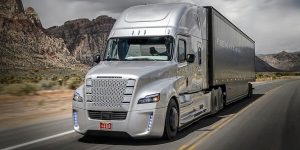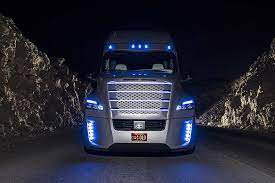Are Driverless Trucks in Your Company’s Future?
Perhaps you’ve seen recent news reports about Google’s driverless car, along with predictions that automated “driving” is just around the corner. Whether you think that’s weird or cool, you should know that industry experts say the future of driverless vehicles is in trucking, not passenger cars.
So hold off on ordering that Google project car and start thinking about the possibilities of adding driverless trucks to your fleet, especially if you manage long-haul operations.
Highway driving is far more predictable than urban and suburban environments.
 Automated and semi-automated technologies lend themselves best in circumstances where there is least risk of human driver unpredictability. Although driverless vehicles have proven their ability to negotiate expected impediments such as stop signs and traffic pattern changes, they aren’t – yet, anyway – able to react to unforeseen situations.
Automated and semi-automated technologies lend themselves best in circumstances where there is least risk of human driver unpredictability. Although driverless vehicles have proven their ability to negotiate expected impediments such as stop signs and traffic pattern changes, they aren’t – yet, anyway – able to react to unforeseen situations.
On the other hand, the relative simplicity of highway configuration offers many miles of consistent speed without lane changes.
Fleet managers can reap significant benefits.
Using a single human driver to lead an entire convoy of trucks to their destination substantially reduces your labor and related overhead costs. And while the loss of professional truck-driving jobs may seem like a negative to those outside the industry, fleet managers know full well that there’s an overwhelming and persistent shortage of qualified drivers.
In fact, the American Trucking Association has noted that last year there was a 98% turnover rate for long-haul truckers. So driverless trucks could turn out to be a real boom to your bottom line as well as your daily operations.
Then there’s the fuel savings. Vehicles traveling nose-to-tail can take advantage of the same drafting physics used by race car drivers and bicycle racers, maintaining speed while burning less fuel and producing less CO2 and fewer emissions. Less wear-and-tear means reduced maintenance costs as well, and automated convoys may even offer safety advantages for both trucking companies and other drivers on the road.
How do driverless trucks work?
 Trucks can be “tethered” by a system of sensors, or in the case of military convoys in battle zones, they’re remotely-controlled but also physically tethered using rugged Kevlar ties.
Trucks can be “tethered” by a system of sensors, or in the case of military convoys in battle zones, they’re remotely-controlled but also physically tethered using rugged Kevlar ties.
Japan has been testing convoys that consist of a lead truck with a human driver followed by several trucks or cars operated via remote sensors. The Japanese are working to develop computerized remote control of the convoys. In Europe, the Safe Road Trains for the Environment program started back in 2009, using a combination of radar, fixed lasers and cameras to manage a “platoon” of vehicles, typically a lead truck and driver followed by a series of cars.
Here in the US, the federal Department of Transportation has published official policies governing road-testing of self-driving trucks. The guidelines apply only to California, Nevada and Florida, states where driverless vehicles are already allowed.
Automated vehicles are proving valuable for off-road uses, too, where conditions are particularly inhospitable for human drivers. Rio Tinto, one of the world’s largest mining companies, has been steadily increasing the number of automated trucks and trains in use at their mines in western Australia, and mining operations in Chile are also using driverless dump trucks to carry ore and other materials.
Semi-automated driving isn’t actually new.
If your car is equipped with cruise control, computer-assisted parallel parking or any of the new-on-the-market accident-prevention technologies, you’ve already gotten a feel for the driverless experience.
Of course there are still plenty of practical challenges relating to entirely automated vehicle, among them liability questions. If an automated vehicle causes an accident, who is at fault? The manufacturer? The owner?
Expect to see the advent of driverless vehicles, especially commercial long-haul trucks, coming to a roadway near you in the not-so-distant future.
